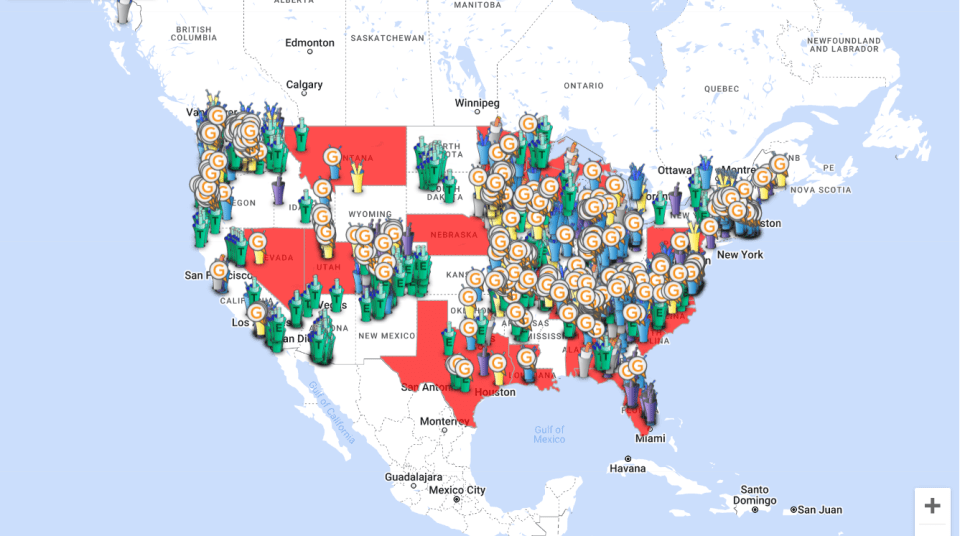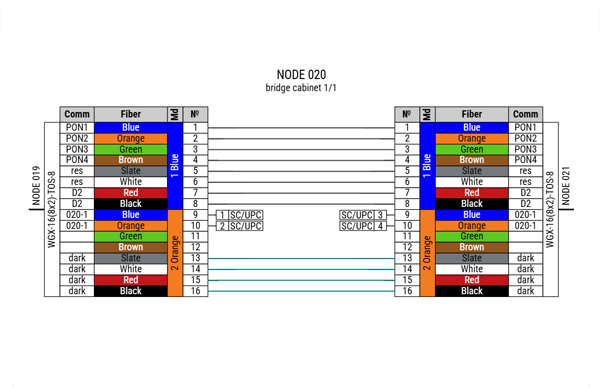FTTH planning has become the gold standard in modern broadband infrastructure with the explosive demand for high-speed internet. However, building a reliable FTTH network is far from simple. It requires careful FTTH planning, smart software tools, and a deep understanding of network design principles. In this post, we’ll explore everything about FTTH planning tools, giving you a full view of how to efficiently plan and design FTTH networks.
What is FTTH planning?
FTTH planning refers to the process of designing and preparing fiber optic networks that deliver high-speed internet directly to end-users’ locations. The process includes everything from route selection, capacity forecasting, duct and cable layout, to fiber splice and connection planning.
The goal of effective FTTH network planning is to optimize costs, minimize maintenance, and ensure long-term scalability.
FTTH planning and design: key stages
- Feasibility study – evaluating the project’s viability
- Route and area analysis – urban vs. rural deployment challenges
- Network architecture selection – FTTH, PON, hybrid solutions
- Network mapping, optical loss budget calculations, tech drawings, etc.
- Bill of materials
- Fiber splicing plans (splice sheets/diagrams/matrixes)
Whether you’re working on a small FTTH project or a state-wide rollout, skipping steps in FTTH network planning and design can result in inefficiencies and costly revisions.
FTTH planning tools and software
- GIS-based solutions
- Automatic route and material calculation
- Real-time cost estimation
- Compatibility with general purpose design tools like Autocad
- Seamless handoff to field technicians
- Mobile version for field techs
- Capabilities to integrate with CRM, monitoring, project management
Advanced FTTx FTTH network planning and design software tools also allow for integration with construction management, workforce management, inventory systems, and permit workflows.
The role of a FTTH planner
- Assessing technical specifications, as these are the key things the future network should comply with.
- Moreoften – formulating the technical specifications for oneselves, as some critical specs can be missing, or even the whole thing.
- Assessing the overall network coverage and coverage area boundaries.
- Assessing topography, which means defining the need for land surveys. A FTTH planner decides where to send surveyors, what should they look for, e.g. paths, ducts, utility poles, obstacles.
- Creating fiber distribution models, calculating the needs and reserve fiber count.
- Slow and painful fiber mapping.
- After fiber plans are approved – proceeding with fiber optic budget loss calculations, technical drawings, down to pole loading analysis and pole make-ready engineering.
- Creating fiber splice diagrams for each and every splice point.
- Finalizing FTTH plan details in coordination with engineers and stakeholders.
- And a lot of other slow and painful work.
Comparative table of FTTH planning tools available
| Software | Strengths | Limitations | Notes / Results |
Splice.me  |
Fast Lightweight Friendly UI |
Scaling to enterprise may challenge | Perfect for fast fiber-level design, splice diagrams, tracing, etc |
| SchemaFiber | Fast schematic modeling, dense networks | Limited GIS & field tools | Regional planning optimized |
| OSPInsight / IQGeo | Comprehensive GIS + lifecycle Robust analytics | High setup complexity | Enterprise-grade, award-winning, expensive |
| Patch Manager | Detailed asset/port management 2D/3D visual REST API |
Less FTTH design automation | Good documentation workflows |
| CrescentLink (Geograph) |
Deep ArcGIS integration Connectivity automation |
Requires ArcGIS licensing | Strong mapping features |
| FiberManager (Schneider) |
Great mapping capabilities | Steep learning curve | Can do pretty everything |
| VETRO FiberMap | User-friendly Fast onboarding Can do all things |
Scaling to enterprise may challenge | Highly rated by users Very expensive |
| FiberPlanIt | Easy to operate | When you aren’t familiar with QGIS | Has lots of pros and cons |
| FibKit | Minimal, clear UI Ideal for cable inventories Affordable |
Limited features | Clarity-first ops tool with limitations |
| COS Systems | Strong OSS/BSS Lots of automation & integrations |
Too complex for design only | Enterprise-grade Expensive |
| netTerrain (GraphicalNetworks) |
Strand-level GIS mapping Strong DCIM features |
Map-focused Limited algorithmic planning |
Excellent capacity planning |
| CoconFiber | SaaS asset management Oracle backend Detailed network visualization |
Field integration depends on modules | Broad EU adoption |
| CircuitVision cvFiber | Full OSP mapping Splice/patch design Circuit tracking |
OSS-focused Modular |
Can become costly |
| Continuum | Schematic drawings Fiber diagrams |
Very specific Not user friendly |
CAD schematic focused |
| INOVA TeleCAD‑GIS | AutoCAD + GIS auto-schematics Routing tools |
Requires AutoCAD Enterprise pricing |
For Autocad lovers |
| NetStork | Route planning Field/offline support Coax/copper features |
Niche product | Rapid path computation |
| 3‑GIS | Unified GIS Powerful planning Mobile ops Can do copper+fiber | Your budget | Web/mobile/CAD strong platform CRM+billing Expensive |
| CableScout (Superiortec) |
Lightweight planning Fiber/cable tracking |
Limited field tools | Unusual UI |
| CableScout (Josoftware) |
Mapping Splicing Cabinets and floor plans Cool UI |
Very specific features | Enterprise-grade Expensive |
| UserSide | Can scan your network Auto-draw features |
Consists of modules | More of a CRM+billing |
| MapItRight | Simple web-based mapping Affordable |
Limited automation | Entry-level planning |
| Render Networks | AI automation Powerful mapping Resource management Field operations |
Your budget | Enterprise-grade Expensive |
| Biarri Networks | Algorithmic planning Auto calcs Modern UI |
Too complex for design only | Algorithmic focus Less human control Expensive |
| GeoStruct | Can calculate ROI, capex, opex, etc Strong field ops |
Too heavy for planning only | Recognized expert-level solution Expensive |
| FNT software | Complex tasks Strong OSS/BSS |
Less FTTH design automation | Can-do-all solution |
| Lepton software | Strong mapping tools Mobile ver For large teams |
Too complex for design only | Enterprise-grade Expensive |
| FiberBase | Can do planning ROI Asset management |
Based on MapInfo GIS | Slow Outdated UI |
| Sitetracker | Full network management CRM | Too heavy for planning only | Enterprise-grade Expensive |
| SIT Digital | Mapping Assets management Field ops |
ArcGIS based Modular | More of a OSS |
| Weezie Fiber | Mapping Cost calcs Field and task ops |
Limited features Limited splicing |
Has lots of pros and cons |
If you need to go deeper
In recent publications authors propose a detailed mixed-integer programming (MIP) model to optimally dimension real-world FTTH networks, focusing on minimizing capital expenditures (CAPEX) covering active equipment (like OLTs), passive components (splitters, cables, splices), site preparation, and labor. Their studies include:
– Heuristic-first approach, which is fast, local-search-based initial designs.
– MIP polishing, where a modular MIP model refines heuristically generated solutions, striking a balance between exactness and scalability.
The MIP doesn’t oversimplify. It includes critical cost and power constraints such as splitter count and attenuation, although some elements (like cabinet sizing) are simplified to maintain tractability. Unlike many prior models that simplify splitters, trenching or ignore infrastructure, this research integrates real‑world considerations, making the model more practical for urban deployment. Also it shows how MIP can improve heuristic outputs in terms of cost efficiency, even for large networks.
As a result, the hybrid heuristic + MIP approach produces better CAPEX results than heuristic-only methods. Pure exact MIP alone is less efficient at scale. The hybrid method offers a practical compromise for large deployments. This enables cost-effective, scalable FTTH network planning, preserving realism with infrastructure and budgeting accuracy.
What FTTH planning software already has such capabilities – you need to study yourself.
And remember
While FTTH planning shares foundational elements with general telecom or broadband network planning, FTTH introduces unique constraints, design principles, and performance expectations. Here’s how it differs:
FTTH requires careful splitter placement and fiber tree design to balance signal loss, distance, and cost. Every connector, splitter, splice, and meter of fiber adds loss, and you must stay within the OLT budget.
FTTH is extremely granular – planning must go down to each individual home, driveway, and building entry point. It requires exact street-level GIS data, property boundaries, and detailed drop fiber routing. Often it means you have to walk-out, see everything for yourself, and take thousands of pictures.
The most expensive part of any FTTH roll-out is civil works (digging, trenching, conduits, permits), sometimes it reaches 75% of network’s total cost. FTTH planning often involves existing utility poles, needing pole loading analysis, make-ready engineering, permitting – can the pole structurally handle new fiber? Are relocations required?
FTTH deployments target tens or hundreds of thousands of endpoints, but each one is simple and passive (usually). Hence FTTH planning benefits greatly from automated design approach, which can generate thousands of network variants, or calculate trench lengths, splitter ratios, material lists, when other types of networks often require more manual or customized planning.
Need help planning your next FTTH network roll-out? Reach out to our team for a consultation or demo of our FTTH planning solutions.
Take care of your splice sheets
1000+ ISPs are already saving weeks of work with Splice.me!




